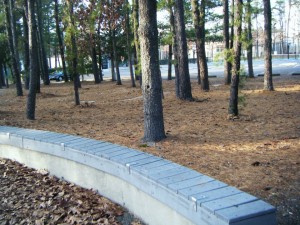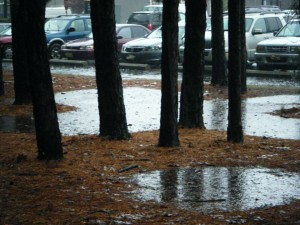When starting Rewilding, we chose to trial all of the cover types in a single location on campus. Small meant we could make sure some of the techniques and cover types would overwinter well in our cold climate and look good the following year without a huge financial (unsustainable) commitment before expanding the program campus-wide. Two of the cover types in particular, the dwarf clover and the native fescue, have not been used here in Vermont on a large scale, so we were curious.
Happy to say, all is well, and at least from my point of view as a horticulturist, successful. Here are some mid June pictures.
Native Fescue

The native fescue zone on top of the hill by Centeno is spectacular. We treated this area last fall as an addition to the trial, and it is now nearly a pure stand of red fescue. It is going to seed now, and will probably ripen and turn a brownish green for the rest of the summer. We’ll mow it down in the fall, using a flail mower.

Near a Siberian elm in this area are some sprouts of the same tree, probably off of surface roots. Never a problem when this area was a mown lawn, we’ll probably go in there in a couple of weeks and manually cut them down to remove them. Not an area we want a grove of trees!

Going back down to the library quad, the large area of fescue in the center quad is also looking nice, though not as tall or fully in seed as the Centeno area. A couple of weeds are in there, including a stand of Milkweed we’re definitely leaving there for the Monarchs-no need to pull that. Overall, I’d give the Centeno stand an A, while this stand, looking back, is about a B/B-. (I’ve been told in my class evaluations I’m a tough grader, so take this as you will)

Lowest still in that quad, near the corner of South Main and Storrs Ave, is our final patch, coming in at I’m going to say about a C-. There are some nice patches of fescue, but they are scattered, and not a lot of it has set seed for this year. There are also a lot of ‘break through’ weeds, so it is not a pure stand. Even other types of grasses are still in there, including Red Top and Orchard grass.
Our suspicion is that Red Fescue prefers higher, drier ground, and soils not especially heavy in clay. This bodes well for large areas of campus, as we sit on a limestone ledge, and much of the campus is quite dry. We’ll keep going with this low section, see how well it does in succeeding years, but my gut says we’ll be better off picking these zones as other types, such as park lawn or Clayplain forest trees.
Clover Lawn

The dwarf clover zones are stunning. Coming up from Storrs Avenue they are on either side of the walkway, and have been in full bloom for a couple of weeks now.


First thing in the spring these started to green up, and it was about 60% clover and 40% grass, by eyeball. (We weren’t counting blades for a population study…)
However, how much of this is indeed the Dwarf clover and how much is Dutch white clover (the ‘lawn weed’)? Eyeballing it again, we’re going to say much of this is the standard white clover, and while the dwarf is present, as a sublayer lower down, but the standard dwarf white clover here probably would have worked fine. We’re rethinking our management of these sections, and while overall it’s successful botanically we’ll see if the height (closer to 4″) is acceptable this close to a building as we progress through the summer.
Park Lawn
We’re through Commencement (traditionally Memorial Day weekend) and Reunion (two weeks after that) so we’re starting a new area of ‘Park Lawn‘ below Gifford Hall on the tree covered ledge. Our management for this cover type was exactly this-get through the high trafficked and noticed times for our landscape in the spring, and then stop mowing sections of campus that don’t see much use, or sun.
These areas traditionally don’t grow too fast after the spring, and we’re taking a cue from area dairy farms. ‘First Cut’ when haying fields is always long, grassy, and bulky, made up mostly of our cool season grasses that grow and flower in the springtime, and then go dormant in the heat of the summer. In a hay field this means the clover, alfalfa, and other forage crops have their chance to shine.
In a lawn, this means that removing the bulky parts of the actively growing grass in the spring means we can time our dormant mowing season to theirs, and hopefully the remaining grass will get long-ish, but not overwhelming. We’ll probably mow these down in the fall sometime.















You must be logged in to post a comment.